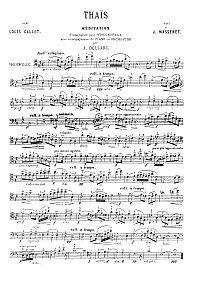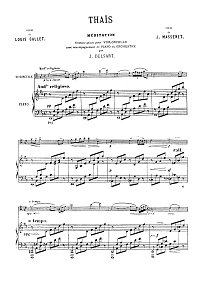Massenet – Meditation for cello and piano
Massenet – Meditation for cello and piano. You can download the PDF sheet music Massenet – Meditation for cello and piano on this page. This excellent musical composition is the classical sample of music for string instrument by the well-known composer. The piece is in D major and is approximately five minutes long (although there are a number of interpretations that stretch the piece to over six minutes). This composition delights the listener by the iinteresting changes of melody and different musical characteristics.
To view the first page of Massenet – Meditation for cello and piano click the music sheet image.
|
| PDF format sheet music |
|
|
|
Cello part: 1 pages. 114 K
|
Piano part: 4 pages. 420 K
|
 |
 |
|
|
| Download PDF (14.99
€) |
Download PDF (14.99
€) |
| "Méditation" is a symphonic intermezzo from the opera Thaïs by French composer Jules Massenet. The piece is written for solo violin and orchestra. The Méditation is an instrumental entr'acte performed between the scenes of Act II in the opera Thaïs. In the first scene of Act II, Athanaël, a Cenobite monk, confronts Thaïs, a beautiful and hedonistic courtesan and devotée of Venus, and attempts to persuade her to leave her life of luxury and pleasure and find salvation through God. It is during a time of reflection following the encounter that the Méditation is played by the orchestra. In the second scene of Act II, following the Méditation, Thaïs tells Athanaël that she will follow him to the desert.
Massenet may also have written the piece with religious intentions; the tempo marking is Andante religioso, signifying his intention that it should be played religiously (which could mean either strictly in the tempo or literally with religiously-founded emotion) and at walking tempo. The piece opens with a short introduction by the harps, with the solo violin quickly entering with the motif. After the violin plays the melody twice, the piece goes into a section marked animato, gradually becoming more and more passionate (Massenet wrote poco a poco appassionato). The climax is reached at a place marked poco piu appassionato (a little more passion) and is then followed by a short cadenza-like passage from the soloist and returns to the main theme. After the theme is played twice, the soloist joins the orchestra while playing harmonics on the upper register as the harps and strings quietly play below the solo line. |
|